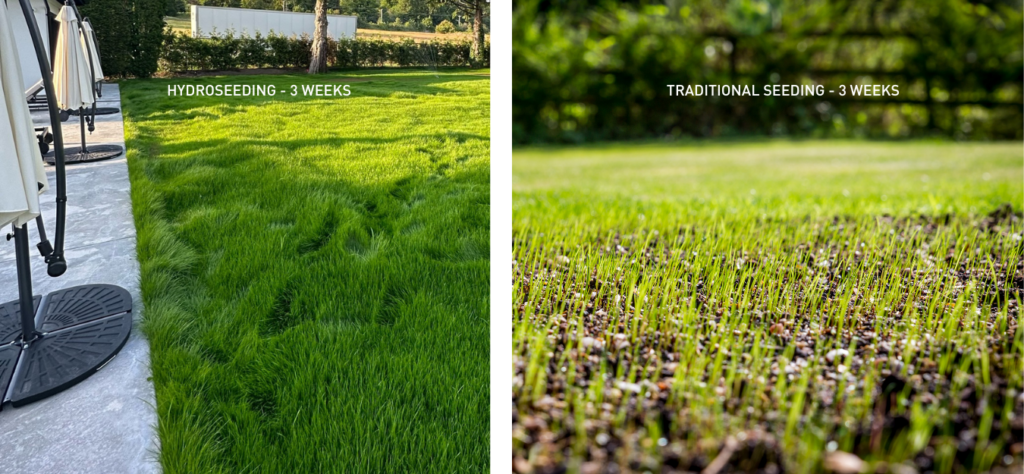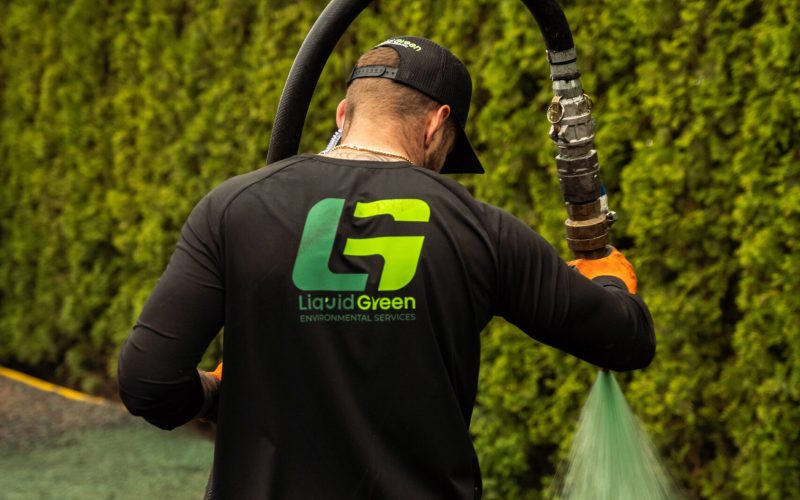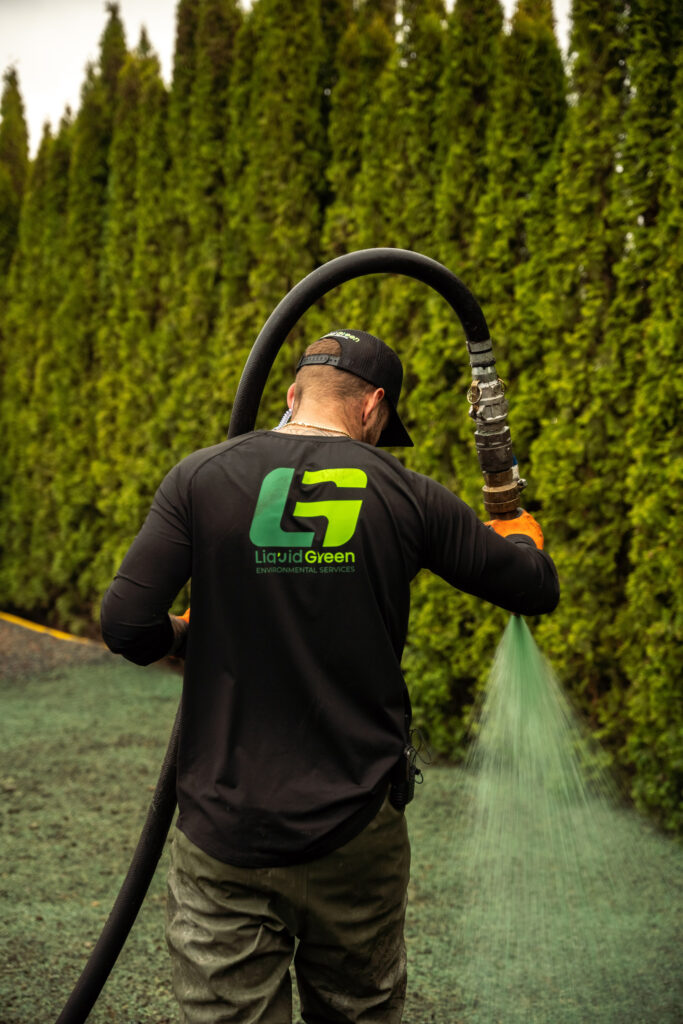9 Hydroseeding Benefits - The Green Revolution
Hydroseeding is a planting method that involves spraying seed mixture onto soil for efficient and uniform grass or wildflower growth. Hydroseeding mixtures typically consist of seeds (such as grass or other vegetation), mulch (often wood fiber or paper), fertilizer, water, and sometimes additives like tackifiers or soil stabilizers.
This method is becoming very popular amongst homeowners and business owners due to the cost-effectiveness, fast results and environmental benefits. In addition, hydroseeding benefits can provide expedited grass growth results during optimal seasons compared to traditional seeding.
Liquid Green Hydroseeding and Environmental Services offers eco-friendly solutions, preparation services, advanced seed mixtures, erosion control, and reclamation services. Our team can help you bring your outdoor goals to life while ensuring that your budget is met. Invest in your lawn today and get started on building strong grass roots that last season after season with hydroseeding!
Hydroseeding offers numerous advantages over traditional seeding methods. Firstly, the advanced seed mixture provides even coverage across large areas, reducing labor costs and ensuring uniform growth. The slurry mixture includes mulch, fertilizer, and water, creating an ideal environment for seed germination and root development. Additionally, hydroseeding helps prevent soil erosion, making it suitable for slopes and disturbed terrain. This makes hydroseeding optimal for difficult to reach areas as well as residential lawns.
Compared to traditional seeding, hydroseeding is faster, more cost-effective, and promotes healthier plant growth. It's also customizable, allowing for tailored seed mixtures to suit specific soil and climate conditions. Furthermore, hydroseeding benefits environmental sustainability by reducing the need for chemical herbicides and promoting the use of eco-friendly additives.
Liquid Green Hydroseeding stands out as a leader in hydroseeding services within British Columbia. With our commitment to eco-friendly solutions, advanced seed mixtures, erosion control expertise, and reclamation services. Our team at Liquid Green offers a comprehensive and sustainable approach to landscaping and vegetation establishment. We will ensure that your results are up to our standard.
Hydroseeding Benefits & How They Compare to Traditional Seeding
Cost Efficiency & Economic Benefits
Hydroseeding has gained popularity amongst homeowners and business owners because it is notably cost-effective due to its efficiency and reduced labor requirements compared to traditional seeding methods. With its ability to cover large areas quickly and evenly, the benefits of hydroseeding minimize both material and labor costs while ensuring optimal seed germination and growth.
For Liquid Green's hydroseeding services, the cost of 1 acre of land typically ranges from 15-18 cents per square foot. This depends on factors such as seed mixture complexity, site accessibility. Our team offers free quotes to determine the hydroseeding cost before you commit to your project.
How it Compares with Traditional Seeding
Traditional seeding methods tend to be more costly due to their labor-intensive nature, requiring more manpower for seeding and watering. Additionally, traditional methods often result in uneven growth, necessitating higher maintenance costs for reseeding and erosion control. This can be frustrating for homeowners due to the spending increase and unpredictable results.
Moreover, the increased water usage with traditional methods adds to the expense. However, with the advantages of hydroseeding covering large areas, it is easy with less labor. In addition, hydroseeding promotes uniform growth, and reduces long-term maintenance needs while being a cost-effective solution.
| Cost benefits of hydroseeding over traditional seeding | |
|---|---|
| Cost Factor | Traditional Seeding |
| Initial Investment | *lower seed costs *higher maintenance can increase initial investment *higher soil preparation |
| Application Process | *Labor-intensive manual spreading *Larger areas experience increased costs |
| Material Usage | *Requires higher seed volume due to uneven distribution *Additional materials required to cover seeds |
| Water Usage for Establishment | *Increased water usage *Water-intensive regions experience higher costs |
| Long Term Financial Impact | *Reseeding *Additional maintenance *Erosion control |
| Maintenance Costs Post-Application | *Higher due to uneven growth *overseeding & additional watering may be needed |
Environmental Advantages
Erosion control is crucial for safeguarding the environment as it prevents soil loss, protects water quality, and preserves ecosystems. Hydroseeding plays a vital role by stabilizing soil, promoting vegetation growth, and reducing runoff, thus minimizing erosion's harmful effects. Moreover, the mulch in hydroseeding mixtures enhances soil health and structure by retaining moisture and nutrients.
Compared to traditional methods, hydroseeding requires less water, conserving this precious resource. Additionally, by fostering plant growth and reducing the need for herbicides, hydroseeding contributes to carbon sequestration, thus mitigating climate change. Significantly reducing the environmental footprint associated with soil erosion and degradation is only one of the many benefits of hydroseeding.
How it Compares with Traditional Seeding
A large benefit to hydroseeding is its exceptional erosion control and soil improvement capabilities without heavy reliance on plastic or netting materials common in traditional seeding. This is because hydroseeding creates a protective layer with seed slurry and mulch, hydroseeding stabilizes soil, preventing erosion and promoting healthier plant growth. This approach not only minimizes environmental impact but also fosters sustainable landscaping practices. With hydroseeding, you can achieve effective erosion control and soil enhancement.
Rapid Germination and Growth
Unfortunately, in modern-day landscaping, many plastic materials are used. Thankfully, hydroseeding excels in erosion control and soil improvement without relying on extensive plastic or netting materials common in traditional seeding.
By utilizing mulch and seed slurry, hydroseeding forms a protective layer over the soil, stabilizing it and preventing erosion. This method enhances soil structure and fertility by retaining moisture and nutrients, promoting healthier plant growth. Unlike traditional seeding, the benefits of hydroseeding include minimized reliance on synthetic materials, offering a more environmentally friendly approach to landscaping and erosion control.
How it Compares with Traditional Seeding
Traditional seeding is very common for landscaping companies, however as mentioned the use of plastic materials is prevalent and costly. In addition to the increased cost of materials, traditional methods often lead to uneven growth, and soil erosion. In contrast, hydroseeding promotes superior grass seed germination and growth by providing even coverage, stabilizing soil, and conserving water. Its eco-friendly approach and effective results make hydroseeding the preferred choice for sustainable landscaping and erosion control. Overall, hydroseeding is superior for germination and growth.
Versatility and Customization
Hydroseeding has the benefit of being versatile and customizable for homeowners and businesses. Hydroseeding's versatility makes it suitable for diverse terrains, including challenging landscapes like slopes or barren terrain. Its customizable seed mixtures cater to different environmental requirements, incorporating drought-resistant grasses and native species as needed.
Hydroseeding finds applications across residential lawns, commercial developments, and public projects such as parks or highway embankments. For residential customers, hydroseeding provides homeowners with lush, uniform lawns quickly and cost-effectively.
Commercial projects benefit from their efficiency and environmental sustainability, while public projects appreciate their erosion control capabilities. Overall, hydroseeding benefits adaptability and effectiveness make it a preferred choice for establishing vegetation in various settings and terrains.
How it Compares with Traditional Seeding
Traditional seeding does not compare to hydroseeding's adaptability and effectiveness, especially in challenging terrains. Uneven lawns are common with traditional methods, leading to higher maintenance costs and inflated pricing, particularly for complex landscapes.
Thankfully, hydroseeding offers customizable seed mixtures and efficient application, ensuring even coverage and healthier growth, even in difficult terrain. Its ability to tackle such challenges while maintaining cost-effectiveness makes hydroseeding the best choice for residential and commercial landscaping projects.

Labor and Time Savings
There are many benefits of hydroseeding. An example being the efficiency in vegetation establishment, rapid germination, and growth rates make it highly advantageous. With specialized equipment and a streamlined process, hydroseeding delivers fast and uniform results over large areas, minimizing project duration and labor costs.
A Liquid Green residential property that was sprayed in July during Vancouver's hot summer saw visible greening within three weeks of hydroseeding. This was done with proper watering and soil preparation.
Furthermore, hydroseeding maintenance is minimal, thanks to its robust root development and weed suppression properties. Overall, the benefits of hydroseeding, including speed, uniformity, and reduced maintenance, make it the preferred choice for cost-effective and sustainable landscaping projects.
How it Compares with Traditional Seeding
On average in British Columbia, individuals can spend several months waiting for a lush lawn to develop with traditional seeding, compared to the rapid results of hydroseeding. Additionally, traditional seeding often needs multiple maintenance sessions throughout the season, including watering, weeding, and reseeding to address patchy growth and weed infestation. In contrast, hydroseeding significantly reduces the time and effort required for lawn maintenance, providing a quicker, more efficient path to a vibrant and healthy landscape.
Water Retention and Soil Protection
During the hot summer months, water retention is very important to ensure seeds are able to germinate.
Hydroseeding benefits include water retention through its mulch layer, which acts as a protective barrier against evaporation and runoff. This mulch layer shields the soil from direct sunlight, reducing moisture loss and maintaining a consistent level of hydration crucial for seed germination and plant growth.
In drought-prone areas, where water scarcity is a significant concern, hydroseeding's ability to conserve moisture has become paramount for ensuring a successful vegetation establishment.
Additionally, the mulch layer provides insulation, protecting seeds from extreme temperatures and promoting more robust root development. Remarkably, hydroseeding typically uses significantly less water compared to traditional methods, with approximately 1,000 gallons of water required per 10,000 sqft, making it an environmentally sustainable choice for landscaping projects.
How it Compares with Traditional Seeding
Traditional seeding methods often rely on more water-intensive processes, especially in warmer seasons. In comparison to hydroseeding, traditional methods typically require a higher volume of water, with approximately 8,000 to 10,000 gallons of water per acre used during the seeding process. This increased water usage contributes to higher costs and greater environmental impact, making hydroseeding a more efficient and sustainable alternative for establishing vegetation in various landscapes.

Custom Solutions for Unique Challenges
Our team provides in-person quotes so we can ensure that we tailor our hydroseeding process to your specific needs.
One of the benefits of hydroseeding is that the mixtures are highly adaptable, tailored to specific challenges in various landscapes.
In erosion-prone areas, hydroseeding formulations include erosion-control additives and fast-growing grass species with robust root systems to stabilize soil quickly.
In drought-affected regions, hydroseeding blends incorporate drought-tolerant grass varieties and moisture-retaining mulches to conserve water and promote plant survival.
Conversely, in low-light urban environments, hydroseeding formulations may contain shade-tolerant grasses and fertilizers suited for limited sunlight conditions, ensuring successful lawn establishment despite shading.
This adaptability demonstrates hydroseeding's versatility in addressing diverse landscaping challenges and providing tailored solutions for achieving healthy and sustainable vegetation in different environments.
How it Compares with Traditional Seeding
In comparison to previous scenarios with hydroseeding, in erosion-prone areas, traditional seeding struggles due to its reliance on surface-level application, leading to inadequate soil stabilization. Often, traditional seeding lacks the ability to incorporate erosion-control additives efficiently, resulting in less effective erosion prevention.
In drought-affected regions, traditional seeding faces challenges in water retention and plant survival, as it often requires higher water inputs and offers limited drought-resistant seed options. Overall, traditional seeding's limitations hinder its effectiveness in adapting to specific challenges compared to hydroseeding.
How Liquid Green Enhances the Benefits of Hydroseeding
Our mission is to be industry leaders in delivering comprehensive environmental services that address the unique needs of our clients and the communities we serve. By leveraging advanced technologies and sustainable practices, we offer tailored solutions that mitigate erosion, promote biodiversity, and improve soil health, resulting in long-lasting, resilient landscapes. We pride ourselves in being certified experts that offer quality services for affordable pricing.
Our Equipment
Liquid Green Hydroseeding operates with a Finn T120 Hydroseeder affixed to an International 4800 4x4 compact semi, enabling access to nearly any space and inclines with ease. Equipped with up to 200 ft of hose, the T120 allows us to efficiently upgrade landscapes. With this system, we can effortlessly spray a mixture of grass seeds over an area of up to 10,000 sq ft in a single load. This is just one of the many hydroseeding benefits.
Service Areas
We proudly serve:
- Vancouver
- Burnaby
- Richmond
- Delta
- Squamish
- New Westminster
- Coquitlam
- Maple Ridge
- Aldergrove
- Surrey
- South Surrey
- Langley
- Abbotsford
- North Vancouver
- West Vancouver
- White Rock
- Chilliwack
Our team also services other areas upon approval. Call today to inquire!
Prompt & Efficient
At Liquid Green, we do our best to fit as many appointments in our schedule as possible. We will always provide the fastest spray time depending on your needs and weather. You can count on us to be on-time, on schedule, and see quick results.
Get a Free Quote & Experience the Full Benefits of Hydroseeding
Hydroseeding Benefits Conclusion
Bringing ease to our customers, our hydroseeding is a comprehensive solution to landscaping challenges, harnessing its efficiency, cost-effectiveness, and environmental sustainability.
Our team will always tailor seed mixture and erosion control measures to address specific terrain and climate needs, ensuring successful vegetation establishment. We will also help you with a proper watering schedule so you can see rapid germination and uniform growth, hydroseeding accelerates the transformation of landscapes, enhancing property value and community aesthetics.
Moreover, its ability to conserve water and suppress weeds reduces long-term maintenance requirements, providing lasting benefits for property owners. If you're ready to start hydroseeding, contact Liquid Green today for a free quote. Let us help you achieve a great landscape that exceeds your expectations.


